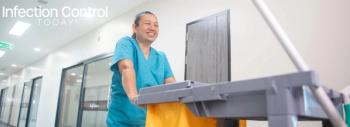
New Materials May Help Prevent Infections by Blocking Initial Bacterial Attachment
Bacterias ability to cling to virtually any surface is a vexing problem in the medical community. Engineering a surface that can easily slough off these dangerous bugs has, until recently, had limited success. Recently, however, a team of British researchers has discovered a new class of materials that resists bacterial attachment. Now these scientists from the University of Nottingham, UK, are ready to set out on the approval process that will take their research to the clinical testing stage, paving the way for medical applications. The researchers will present their findings at the AVS 59th International Symposium and Exhibition, being held Oct. 28 to Nov. 2 in Tampa, Fla.
To date, scientists have been unable to fully explain how bacteria are able to adhere so durably to virtually any surface. Despite this limited understanding of bacteria-material interactions, the Nottingham researchers were able to screen thousands of different chemical combinations for resistance to bacterial adhesion. The studies revealed that one particular class of compounds, acrylates with hydrophobic groups, proved highly resistant to bacterias sticky tendencies.
The new materials are to bacteria what non-stick cookware is to food, says Andrew Hook, a researcher at the Nottingham School of Pharmacy. Bacteria can stick to the surface of [traditional] medical devices and form a community, known as a biofilm, where the bacteria become highly resistant to antibiotics and the immune system.
By preventing the biofilm from forming on devices in service, the new materials help the immune system to simply eliminate the bacteria as if the device had never been inserted. In contrast, current antibacterial materials, like silver, actually kill bacteria.
After the new non-stick materials were identified, they were successfully tested on surfaces in the laboratory and on standard medical devices, such as catheters, within an animal model. In laboratory studies of the new materials, the researchers found a 96.7-percent reduction in bacterial coverage compared to commercially available silver-containing catheters for the bacterium Staphylococcus aureus.
By coating medical devices with the optimal polymer composition of one of this class of acrylates, for example the compound tricyclodecane-dimethanol diacrylate that the researchers tested, scientists believe they can prevent bacteria from attaching and also prevent associated infections, which could reduce healthcare costs.
The researchers are now ready to take their research to the next level and prepare the regulatory package to begin clinical trials. They hope the trials will show that by denying bacteria a foothold on medical equipment in humans, the chances of a patient contracting a medical device-associated infection are much lower.
Nottingham pharmacy professor Morgan Alexander hopes that since no antibiotics are used this will lead to a method to reduce infections from bacteria without the risk of antibiotic resistance developing. The challenge now is to have materials recognized by the medical device industry, Alexander said. That would allow us to develop products for specific applications. Theres a lot of potential to improve human health, but we need to prove that.
The researchers are in discussions with potential partners to develop coated devices and are hopeful their material could reach the market in five to 10 years.
Source: AVS: Science & Technology of Materials, Interfaces, and Processing
Â
Newsletter
Stay prepared and protected with Infection Control Today's newsletter, delivering essential updates, best practices, and expert insights for infection preventionists.






